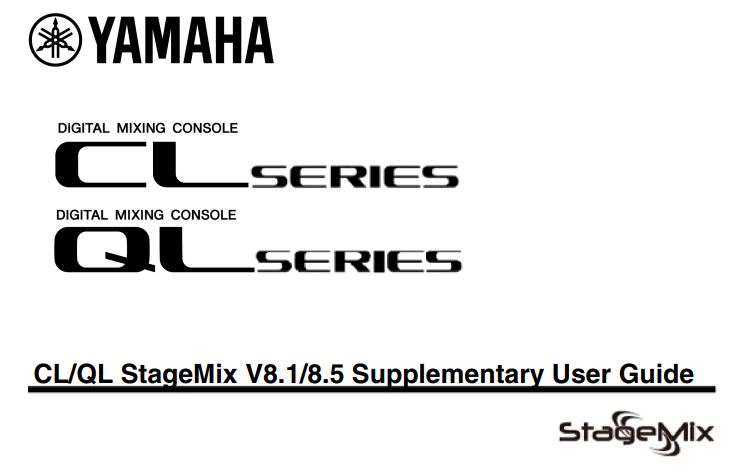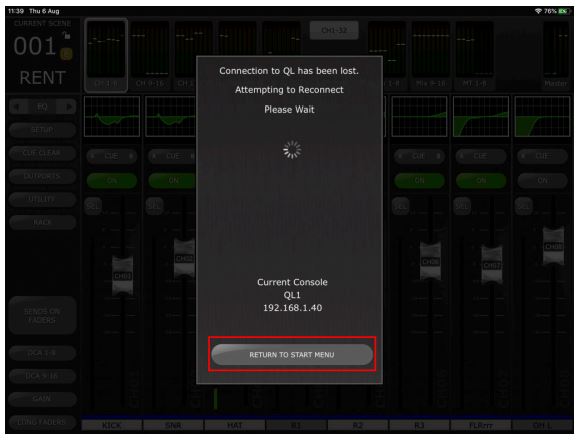Yamaha CL/QL Series StageMix Digital Mixing Console User Guide
YAMAHA CL/QL Series StageMix Digital Mixing Console User Guide

Welcome:
Thank you for downloading the “CL/QL StageMix” iPad app for the Yamaha CL/QL series digital mixing consoles.
This supplementary user guide explains the new features and changes introduced with CL/QL StageMix V8.1 and V8.5.
StageMix is an application for the Apple iPad that provides remote control of Yamaha CL/QL series digital mixing console functions via a simple, intuitive graphical interface from anywhere within wireless range. The software has been specifically designed to allow engineers to adjust monitor mixes from the performers’ positions on stage, directly controlling mix parameters via the iPad rather than having to rely on verbal directions to a second engineer. The result is better mixes in less time; a huge advantage during high-pressure pre-show setup. Although StageMix is focused on the requirements for adjusting monitor mixes on stage, its range of features is continually expanding, allowing it to be used for a wider variety of remote control functions.
NOTE: iOS applications may not be supported in your area. Please check with your Yamaha dealer.
The latest firmware version for CL/QL series can be downloaded from http://www.yamahaproaudio.com/
Disconnect from Console and Return to Start Menu
From V8.1 onwards, CL/QL StageMix now supports iOS multi-tasking. As a result, if StageMix is sent to the background (i.e., if the iPad home button is pressed during operation), StageMix will automatically attempt to re-connect to the previously used console IP address whenever StageMix is re-opened.

To connect to a different console IP address, or if the previously console is no longer available, select the [RETURN TO START MENU] button from the synchronisation pop-up. This will return StageMix to the Start menu, from which another console can be selected, or a new console connection can be created.
NOTE: if a long period of time passes between the app being sent to the background and re-opened, it is likely that iOS will have fully closed the app. In this instance, StageMix will re-open to the Start menu.
It is also possible to return to the Start menu at any time while using StageMix, by touching the [Disconnect and Return to Start Menu] button in the top bar of the SETUP Menu.
However, note that if OFFLINE DEMO is active, if you want to exit and return to the Start menu for connection to an actual console, either use the [Disconnect and Return to Start Menu] button in the setup menu or force-close StageMix and re-launch.
To disconnect StageMix from the current console in order to connect to a different console, use the [Disconnect and Return to Start Menu] button.
Hide Unused MIX/MATRIX Sends
This function applies to the following two StageMix views –
- Sends on Faders view
- Channel Sends view
Whenever this function is enabled, any unused Mix or Matrix Sends will be temporarily hidden from view. The result is that only Sends that are feeding audio to the selected target Mix or being sent from the selected channel, are displayed. This allows the user to quickly identify which channels are actually feeding audio at that moment in time to the target Mix or Matrix, or which Mixes or Matrices the selected input or Mix channel is sending to.
Which Mix or Matrix Sends are actually hidden when Hide Unused is enabled depends on the Mode applied in the SETUP menu together with the state of each Mix or Matrix Send at that moment.
- Send OFF – Mix or Matrix Sends which are currently OFF at the point that Hide Unused is enabled, will be hidden from view.
- Fader -inf – Mix or Matrix Sends with their levels set to -inf at the point that Hide Unused is enabled, will be hidden from view.
- Fader -inf and Send OFF – Mix or Matrix Sends which are set to OFF and have level set to -inf at the point that Hide Unused is enabled, will be hidden from view.
Hide Unused in Send on Faders
Enter SENDS ON FADERS (refer to section 4.11 in the CL/QL StageMix User Guide)
To enable Hide Unused, touch the [HIDE UNUSED] button on the left side bar.
When enabled, any unused channel strips are hidden from view and only active Send Channel strips are displayed in both the main 8 fader view and also in the top meter bridge.
To return to the normal Sends on Faders view and display the send faders for all channels, disable [HIDE UNUSED] at any time from the left side bar.
NOTE: When changing between target Mix or Matrix Sends, or exiting and reentering Sends on Faders, HIDE UNUSED will remain enabled.
Hide Unused in Channel SENDS Editor View
Navigate to the Channel SENDS Editor view (refer to section 5.9 in the CL/QL StageMix user guide). To enable HIDE UNUSED, touch the [HIDE UNUSED] button in the top bar.
NOTE: Hide Unused view status will be automatically refreshed after all of the following operations:
- Scene Recall
- Channel Library recall
- Channel Paste
- Channel Default
- Channel Move
NOTE: Hide Unused view status is not refreshed if any hidden Mix Send is turned ON and/or the Send Level is raised above -inf should these parameters be edited directly from the connected console or from another controller. It is necessary to manually disable and re-enable [HIDE UNUSED] to refresh the view in StageMix. Hide Unused will remain enabled when navigating between channels.
GEQ and PEQ8 libraries
Library Store and Recall for Rack Graphic EQ’s and 8-band Parametric EQ’s (PEQ8) from CL/QL StageMix is now available.
These Libraries can be accessed from either the Rack View or from a corresponding Channel Editor where any Rack based processor has been inserted on the respective channel.
(For Rack access and control, refer to Section 8 of the CL/QL StageMix User Guide.)
When using a GEQ/PEQ8 via the Rack, the Library can be accessed by touching the [LIBRARY] button contained within the top bar of StageMix. This will open a pop-up window which contains a list of all currently stored Libraries of the current processor type within the console.
Select the desired library preset from the list, and touch [RECALL] to apply that library preset to the current GEQ or PEQ8
To store the current GEQ or PEQ8 settings to a new or existing library preset, select the library type and preset number and touch [STORE]. Use the keyboard to apply a name to the preset.
To access these Libraries when using a GEQ or PEQ8 accessed via the Selected Channel Editor view, touch the [LIBRARY] button in the top left corner. Store and Library Recall operations are the same as described above.
Special Notices
- The software and this User Guide are the exclusive copyrights of Yamaha Corporation.
- Copying of the software or reproduction of this manual in whole or in part by any means is expressly forbidden without the written consent of the manufacturer.
- Yamaha makes no representations or warranties with regard to the use of the software and documentation and cannot be held responsible for the results of the use of this manual and the software.
- The screen displays as illustrated in this User Guide are for instructional purposes, and may appear somewhat different from the screens which appear on your computer.
- Future upgrades of application and system software and any changes in specifications and functions will be announced separately.
- Apple, the Apple logo and iPad are trademarks of Apple Inc., registered in the U.S. and other countries.
- IOS is a trademark or registered trademark of Cisco in the U.S. and other countries and is used under license.
- The company names and product names in this User Guide are the trademarks or registered trademarks of their respective companies.
Yamaha Pro Audio global website
http://www.yamahaproaudio.com/
Yamaha Downloads
https://download.yamaha.com/
Manual Development Group
© 2020 Yamaha Corporation
Published 11/2020 YJMK-A1